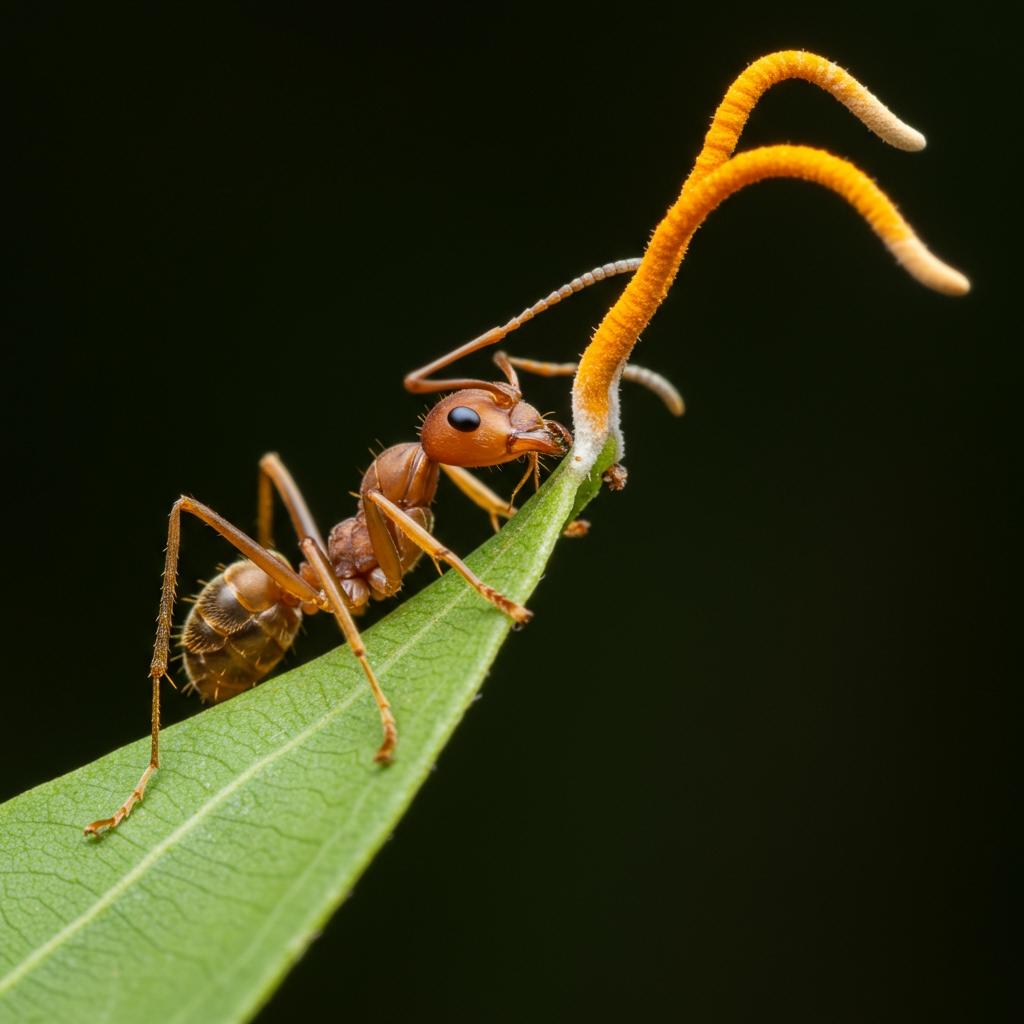The Truth Behind ‘Zombie’ Parasites That Control Animal Minds
 An ant infected by the ‘zombie’ fungus Cordyceps, which hijacks its brain to spread fungal spores.
An ant infected by the ‘zombie’ fungus Cordyceps, which hijacks its brain to spread fungal spores.
By Peter Teoh, Science Writer
Imagine a tiny creature taking over your brain, making you act in ways that benefit it, not you. Sounds like a horror movie, right? But in the natural world, this is exactly what some parasites do—they turn their hosts into real-life zombies. These “zombie” parasites hijack the minds of animals, changing their behavior to spread themselves and survive. Let’s dive into the fascinating world of these mind-controlling invaders.
What Are Zombie Parasites?
Zombie parasites are organisms that infect other animals and manipulate their behavior to help the parasite complete its life cycle. They don’t just live off their hosts—they control them, often making their hosts do things that seem suicidal or extremely risky. But why? Because parasites need to reach new hosts or environments to reproduce and spread.
These parasites include fungi, worms, single-celled organisms, and even wasps. Despite their creepy abilities, they aren’t evil masterminds. Most lack brains or real intelligence. Instead, they evolve chemical and physical tricks to manipulate their hosts’ nervous systems.
How Do Zombie Parasites Control Their Hosts?
The key weapon of zombie parasites is altering brain chemistry. They release chemicals or physically invade nervous tissue to change behavior. Sometimes they:
- Stimulate certain hormones or neurotransmitters (brain chemicals that control mood and actions).
- Grow inside the host’s muscles or brain, physically changing how it moves or reacts.
- Tweak existing behavioral patterns rather than creating completely new ones.
For example, a parasitic wasp injects venom into a spider’s brain, making it build a special web to protect the wasp’s larvae. Once the larvae hatch, they feed on the spider, which is still alive but controlled by the parasite.
Three Mind-Blowing Examples of Zombie Parasites
- Cordyceps Fungus and Ants
This is one of the most famous zombie parasites. The Cordyceps fungus infects ants and floods their brains with chemicals that force them to climb plants and clamp down with a “death grip.” The fungus then kills the ant and grows a stalk from its head to release spores into the air, infecting more ants below. This gruesome process spreads the fungus widely, especially in tropical forests.
- Leucochloridium Paradoxum and Snails
This parasitic flatworm invades snails, making their eyestalks swell and pulsate with bright colors that look like caterpillars. Birds, attracted to these moving eyestalks, eat the snails, allowing the parasite to move into the bird’s digestive system and continue its life cycle. The snail’s behavior also changes—it moves into the open more often, increasing its chances of being spotted.
- Plagiorhynchus Cylindraceus and Pill Bugs
This worm infects pill bugs (those cute roly-polies). The parasite causes the pill bug to act boldly and gather where birds can easily see and eat it. Once eaten by a bird, the parasite reaches its next host, completing its cycle. Without this control, the parasite would struggle to find a bird to infect.
What About Humans?
Humans aren’t completely safe from mind-controlling parasites. Toxoplasma gondii is a single-celled parasite that infects rodents and changes their behavior to make them less afraid of cats, so cats can catch them. Humans can also get infected, and some studies suggest it might influence risk-taking behavior, although evidence is still debated.
Why Doesn’t the Host Die Immediately?
Parasites don’t want to kill their hosts too soon because they rely on them to spread. Many parasites keep hosts alive just long enough to complete their life cycle. After that, it’s often the host’s end—either eaten by a predator or killed by the parasite itself.
The Science Behind Zombie Parasites
Parasites and hosts are in an evolutionary arms race. Parasites evolve better ways to control hosts, while hosts evolve defenses against manipulation. Arthropods—like insects, spiders, and crustaceans—are especially vulnerable because they are ancient, abundant, and have nervous systems that parasites can manipulate chemically or physically.
Scientists keep discovering new examples of these bizarre relationships, showing how complex and surprising life on Earth really is.
Closing Thoughts
Zombie parasites might sound like science fiction, but they are real and fascinating examples of nature’s complexity. They reveal how organisms can evolve mind control without brains or consciousness, using chemistry and biology to survive. Next time you see a bug or a snail, think about the hidden battles going on inside them—tiny parasites pulling the strings in a drama of life and survival.
Side Notes
- Neurotransmitters: Chemicals in the brain that transmit signals between nerve cells.
- Life cycle: The series of stages an organism goes through from birth to reproduction.
- Parasitoid wasp: A wasp whose larvae feed on a host, usually killing it.
Trending Sidebar
- Cordyceps in Pop Culture: The fungus inspired the hit video game and TV show The Last of Us, showing zombie-like infected humans.
- Parasite Mind Control Research: New studies use brain imaging to see how parasites influence host behavior.
- Human Brain and Parasites: Ongoing research explores how microbes might subtly affect human mood and decisions.
Explore the weird and wonderful world beneath the surface—parasites may be tiny, but their power over minds is huge!